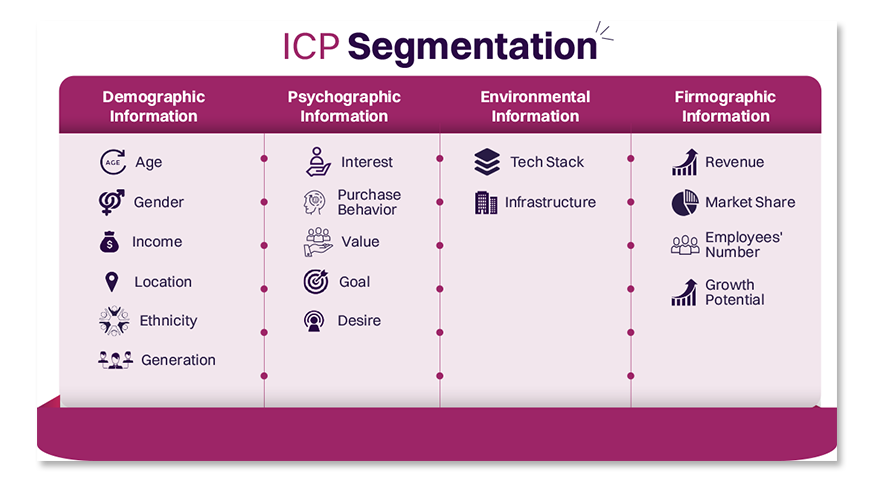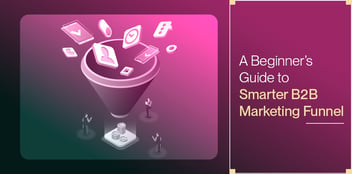
Top 4 Lead Conversion Best Practices In 2024
A successful lead-generation process is crucial for your business to increase its customer base and revenue. In fact, as per studies, 53% of marketers invest almost half of their business budget to generate leads. Thus, ensuring your lead generation efforts generate high-quality leads becomes crucial.
This article will explore some of the best lead-generation practices to help your business succeed.
1. Track And Analyze The Lead Quality

A. Done Your Ideal Customer Profile (ICP) Right
ICP aims to identify accounts with the highest potential to become valuable customers. It assesses their annual contract values (ACV) and lifetime values (LTV). It facilitates the target accounts' segmentation and enables go-to-market alignment.
Segment different data types you can obtain about the customer and use them to create an ICP for your offerings – such as:
Demographic Information
- Age: Helps target specific age groups for relevant marketing campaigns and product/service offerings.
- Gender: Aids in creating targeted marketing messages and product/service offerings that align with gender preferences.
- Location: Enables you to focus your marketing efforts in areas with high potential for customer acquisition.
- Income: Provides insights into purchasing power and helps tailor pricing strategies to target specific income brackets.
- Ethnicity: Helps you understand cultural nuances and create inclusive marketing campaigns and offerings.
- Generation: Enables you to target different age groups with relevant messaging and offerings that resonate with their values and preferences.
Psychographic Information
- Interest: This helps you understand your audience's hobby, passion, and preference to create personalized marketing messages and offerings.
- Purchase Behavior: Provides insights into consumer purchasing patterns and preferences. It allows you to create targeted marketing messages and promotions.
- Value: Helps you align your messaging and offerings with your audience's core beliefs. Thus, it creates a stronger emotional connection and brand loyalty.
- Goal: This enables you to understand your audience's aspirations and tailor your offerings to help them achieve their objectives.
- Desire: Provides insights into consumer wants and needs. Thus, you can create more targeted and relevant marketing messages and offerings.
Environmental information
- Tech Stack: Tools and technologies that your target company uses.
- Infrastructure: Relevant company conditions and work activities.
Firmographic information
- Revenue: The company's income on an annual basis.
- Market Share: The percentage of customers' market share the client company owns.
- Employees' Number: The total number of employees working in the target company.
- Growth Potential: The possibility of the company expanding and developing based on forecasts and past year's growth rates.
Use the combination of this information to create your target ICP.
For example, you may be targeting a female lead with an income above $60k, living near Los Angeles, and having goals to grow her business in terms of the consumer base. Naturally, leads that qualify for these pointers will be the best fit as your ICP.
B. Establish Lead Scoring Criteria
Assign a numerical score to each lead based on the following:- How they fit with your ICP.
- Level of engagement with your brand.
For example, a lead may be seeking similar products/services as you provide. Plus, they may visit your website multiple times, fill out a contact form, and engage with your social media channels. As a result, this lead would receive a higher score than another who only visits your website once.
Here's an example of a lead scoring framework you can use:
| Lead Scoring Criteria | Weight | Score |
| Job Title | 20% | 10 |
| Company Size | 15% | 7 |
| Industry | 10% | 5 |
| Website Engagement | 25% | 12 |
| Email Engagement | 20% | 8 |
| Downloaded Content | 10% | 4 |
In this example, the lead scoring framework includes six criteria with different weights assigned to each based on their importance. Each lead is assigned a score for each criterion based on their behavior and characteristics. Leads with higher scores are considered more qualified and are prioritized for further follow-up and nurturing.
C. Use A CRM (Customer Relationship Management ) System
A CRM system like HubSpot and Salesforce automatically captures, and stores lead data in its unified platform. It lets you track lead behavior, assign lead scores, and analyze lead quality in one place. It aims to enhance productivity and streamline processes by automating important repetitive manual tasks.
Some of the best CRM tools businesses prefer include HubSpot, Salesforce, etc. In addition, marketers who utilize automation software can convert a higher percentage of leads (77%) than those who do not.
D. Analyze Lead Data
Use collected lead data through a CRM system to identify trends and patterns in lead quality. But, before you start, clean the available data, as they can be messy and contain errors. Thus, it's important to enrich and audit your data. It involves:
- Removing duplicates
- Correcting errors
- Standardizing data formats
While organizing data in groups, focus on these two things:
- Common characteristics among your highest-quality leads.
- Factors that contribute to the lead's engagement with your brand. These include:
- Content type
- Channels they use for brand interaction
- The pain point they seek to solve
Now, move ahead to analyze the data. You can use tools and data enrichment techniques like machine learning, data visualization, and statistical analysis to analyze lead data. It will identify patterns, trends, and insights required to improve marketing strategies.
E. Optimize Your Sales And Marketing Efforts
Based on your lead quality analysis, optimize your sales and marketing efforts. It may involve targeting specific customer segments or adjusting pricing and promotions. Ensure to prioritize high-quality leads and use channels your leads prefer to engage with.
Run A/B testing across all changes you make in your sales and marketing efforts to ensure you follow the best practices for the lead generation process. Further, refine your lead generation and nurturing strategies based on updated customer data.
2. Map Out Your Lead Generation Process
.png?width=800&height=612&name=lead-generation-funnel%20(2).png)
Follow the below-given steps to do the task:
Step 1
Begin with identifying your lead generation funnel stages:
- Awareness: The top of the funnel is the awareness stage, where potential customers are just becoming aware of a problem or need they have. Here, you must focus on attracting and introducing them to your brand.
- Consideration: The middle of the funnel is the consideration stage, where potential customers actively research solutions to their problem or need. Thus, you must offer them the required information to build their trust in your brand.
- Decision: The bottom of the funnel is the decision stage, where potential customers are ready to purchase. Thus, you must focus on clearing all the objections and concerns by providing timely information during their purchase journey. Also, consider offering incentives to convert them.
Step 2.
Identify the channels and tactics you'll use to attract and engage potential customers at each stage of the funnel. Such as:
For TOFU (Top Of The Funnel):
- SEO: Search engine optimization (SEO) to boost your website’s ranking in search engine result pages.
- Social Media: Social media marketing (SMM) to boost your brand’s awareness and visitor engagement.
- Content marketing: Content such as blog posts, videos, and infographics, to educate potential customers and establish thought leadership.
- Display Advertising: Do it to reach a wider audience and increase brand recognition.
- Influencer Marketing: Leverage it to reach and credibility of influencers in your industry.
For MOFU (Middle Of The Funnel):
- Email marketing: To nurture leads and provide targeted information based on their interests.
- Retargeting Advertising: To remind potential customers of your brand and encourage them to revisit your website.
- Webinars or Live Events: To provide more in-depth information and answer questions.
- Case Studies: Or customer success stories demonstrate the value of your product or service.
- Interactive Content: Such as quizzes or assessments, to engage potential customers and provide personalized recommendations.
For BOFU (Bottom Of The Funnel):
- Demos: Sales calls or demos to provide personalized information and answer questions.
- Reviews: Customer testimonials or reviews to demonstrate social proof and build trust.
- Offers: Limited-time offers or discounts to incentivize purchase decisions.
- Freebies: Free trials or samples to allow potential customers to try your product or service before committing to a purchase.
- Remarketing: To encourage potential customers who still need to convert to take action.
Step 3.
Create a timeline for each stage of the funnel. Then, develop a system to capture and track leads as they progress.
3. Align Sales And Marketing Teams
Studies show that misaligned sales and marketing efforts cause companies to lose 10% of revenue yearly.
Thus, the alignment of sales and marketing teams is a must. Here's how to make it happen:
- Develop a shared understanding of your customer personas: You’ll need to consider shared customers' demographics, interests, and pain points to help both teams target a similar audience. Thus, it ensures consistency in messaging and branding.
- Establish clear definitions for lead stages: Define lead stages, such as Marketing Qualified Lead (MQL) and Sales Qualified Lead (SQL). Ensure that both teams use the same criteria for defining and categorizing leads.
- Use a centralized CRM system: Use a centralized CRM system that both teams can access and update. The system ensures both teams have access to accurate, consistent, and up-to-date lead data.
- Hold regular meetings to review data and discuss strategy: Regular meetings between both teams ensure they are aligned on strategy and tactics. In addition, these meetings can review the lead generation's effectiveness and needed adjustments.
4. Tracking Leads Through the Entire Funnel Attribution
You can achieve it using these four steps below:
- Capture your website visitors on an individual level.
- Collect data from various sources in a single platform or a CRM.
- Share collected data with the tools you use daily.
- Lead makes a purchase, and revenue is attributed to its original source.
Full-funnel attribution includes the following parts:
- First-touch attribution: This model credits the customer's first touchpoint with your business as the primary medium for conversion.
Suppose a customer discovers your brand through a Google search. And, then, he purchases your product after receiving your email. Here, the first-touch attribution would give all the credit for the conversion to the initial Google search. - Last-touch attribution: This model credits the customer's last touchpoint with your business as the main medium for conversion. If we use a similar example as mentioned above, the last-touch attribution will give all the credit for the purchase to the email that prompted the customer to purchase.
- Multi-touch attribution: This model credits the multiple touchpoints in the customer journey for conversion. In multi-touch attribution, touchpoints can get equal credit. However, touchpoints may receive different volumes of customer interactions.
Conclusion
Implementing best practices for lead conversion is essential for businesses to attract, nurture, and convert potential customers effectively. Ensure to refine and optimize your lead generation process consistently. It'll improve your sales pipeline and drive growth in a competitive marketplace.
It is advised to take expert guidance to optimize your lead generation process for the best outcomes. We at Revnew offer you refined expertise in creating lead-generation strategies exclusive to your business needs. Ensure to take time out to check out how we helped one of our clients to generate 114 leads and 41 additional contacts within just six months.




